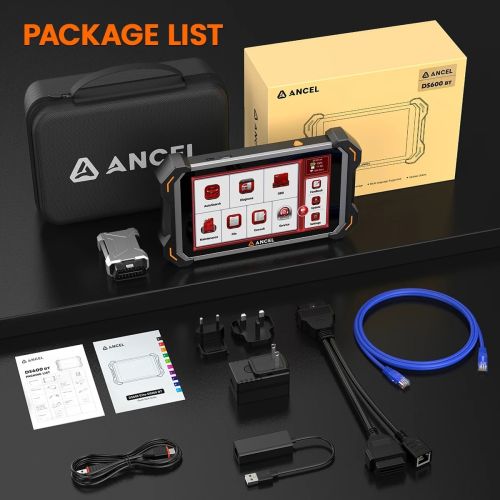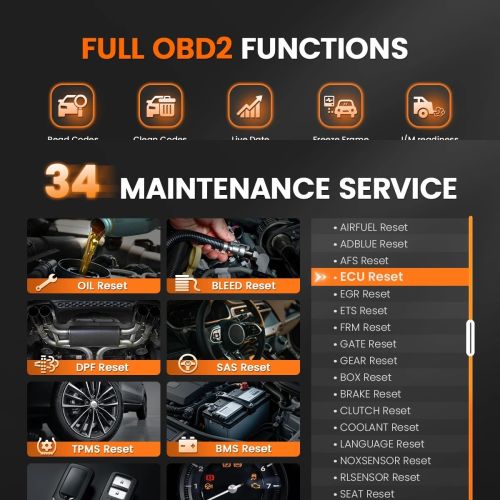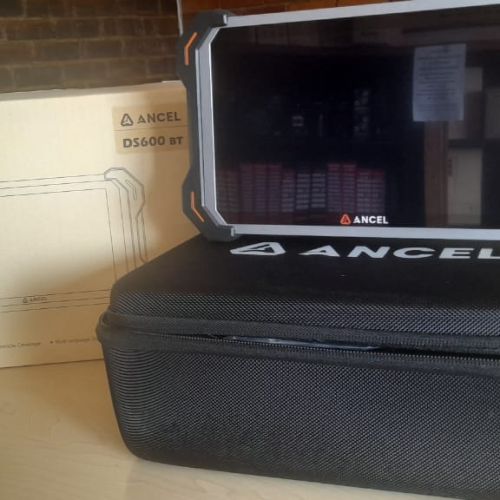
Brand:
Ancel
R12,899.00
Inclusive All Taxes
Sold Out
This Item is Currently Out Of Stock
This Product Is Sold By DIATOOLS To Ask A Question, Click Ask A Question Below
Seller
DIATOOLS
Description
DS600 BT Professional Car Diagnostic Scanner for Passenger Vehicles
Powerful Bi-Directional Control
As a bi-directional scan tool, DS600 BT allows you to request information from a vehicle's ECU or send
commands to the vehicle's modules to perform specific tests and functions, such as EVAP Tests, Turn on/off
radiator fan, Window/Mirror/Door Lock Test, Pump and Value Tests, Sound horn Test, et. Without using the
vehicle control system and dismantling car’s parts, it can quickly and accurately pinpoint the fault causes,
simple operation saves time and money.
34+ Hot Special Functions
1.Oil Reset:
The lightening of the car maintenance light indicates that the vehicle needs maintenance. Reset the cluster or
driving time to zero after the maintenance, so the maintenance light will go out and the system will start a new
maintenance cycle.
2.DPF Regeneration:
DPF Regeneration is used to clear PM (Particulate Matter)from the DPF filter through continuous combustion
oxidation mode (such us high temperature heating combustion, fuel additive or catalyst reduce PM ignition
combustion) to stabilize the filter performance.
DPF regeneration may be performed in the following cases:
a)The exhaust back pressure sensor is replaced.
b)The PM trap is removed or replaced
c)The fuel additive nozzle is removed or replaced
d)The catalytic oxidizer is removed or replaced.
e)The DPF regeneration MIL is on and maintenance is performed.
f)The DPF regeneration control module is replaced.
3.AFS (headlamp) Reset:
The feature is used to initialize the adaptive headlamp system. According to the ambient light intensity, the
adaptive headlamp system may decide whether to automatically turn on the headlamps, and timely adjust the
headlamp lighting angle while monitoring the vehicle speed and body posture.
4.EGR Adaption:
This function is used to learn the EGR (Exhaust Gas Recirculation) valve after it is cleaned or replaced.
5.Brake-pad Reset:
If the brake pad wears the brake pad sense line, the brake pad sense line sends a signal sense line to the on
board computer to replace the brake pad. After replacing the brake pad, you must reset the brake pad.
Otherwise, the car alarms.
Reset must be performed in the following cases:
a)The brake pad and brake pad wear sensor are replaced.
b)The brake pad indicator lamp is on.
c)The brake pad sensor circuit is short, which is recovered.
d)The servo motor is replaced.
6.IMMO Service:
To prevent the car being used by unauthorized keys, the anti-theft key matching function must be performed
so that the immobilizer control system on the car identifies and authorizes remote control keys to normally use
the car. When the ignition switch key, ignition switch, combined instrument panel, ECU, BCM, or remote
control battery is replaced, anti-theft key matching must be performed.
7.Windows Calibration:
This feature is designed to perform door window matching to recover ECU initial memory, and recover the
automatic ascending and descending function of power window.
8.Coolant Bleeding:
Use this function to activate the electronic water pump before venting the cooling system.
9.Steering Angle Reset
To reset the steering angle, first find the relative zero point position for the car to drive in straight line. Taking
this position as reference, the ECU can calculate the accurate angle for left and right steering. After replacing
the steering angle position sensor, replacing steering mechanical parts (such as steering gearbox, steering
column, end tie rod, steering knuckle), performing four-wheel alignment, or recovering car body, you must
reset the steering angle.
10.Injector Coding:
Writing injector actual code or rewrite code in the ECU to the injector code of the corresponding cylinder so as
to more accurately control or correct cylinder injection quantity. After the ECU or injector is replaced, injector
code of each cylinder must be confirmed or re-coded so that cylinder can better identify injectors to accurately
control fuel injection.
11.Seat Calibration:
This function is applied to match the seats with memory function that are replaced and repaired.
12.Transport Mode:
In order to reduce power consumption, the following functions may be disabled, including limiting the vehicle
speed, not waking up the door opening network, and disabling the remote control key, etc. At this time, the
transport mode needs to be deactivated to restore the vehicle to normal.
13.Battery Matching:
This function enables you to perform a resetting operation on the monitoring unit of vehicle battery, in which
the original low battery fault information will be cleared and battery matching will be done.
Battery matching must be performed in the following cases:
a)Main battery is replaced. Battery matching must be performed to clear original low battery information and
prevent the related control module from detecting false information. If the related control module detects
false information, it will invalidate some electric auxiliary functions, such as automatic start & stop function,
sunroof without one-key trigger function, power window without automatic function.
b)Battery monitoring sensor. Battery matching is performed to re-match the control module and motoring
sensor to detect battery power usage more accurately, which can avoid an error message displaying on the
instrument panel.
14.Airbag Reset:
This function resets the airbag data to clear the airbag collision fault indicator. When the vehicle collides and
the airbag deploys, the corresponding fault code of the collision data appears, the airbag indicator lights up,
and the fault code can't be cleared. Since the data inside the airbag computer is disposable, it is required that
all new accessories must be replaced, but after performing this function, the data of the airbag computer can
be recovered and the fault code can be cleared, the airbag light will go out, and the airbag computer can
continue to use.
15.Tyre Reset:
This function is used to set the size parameters of the modified or replaced tire.
16.Cluster Reset
a)cluster reset is to copy, write, or rewrite the value of kilometers in the chip of cluster by using a car
diagnostic computer and data cable, so that the cluster shows the actual cluster.
b)Usually when the cluster is not correct due to the damaged vehicle speed sensor or cluster failure, it is
necessary to do cluster reset after maintenance.
17.ABS Bleeding:
When the ABS contain air, the ABS bleeding function must be performed to bleed the brake system to restore
ABS brake sensitivity. If the ABS computer, ABS pump, brake master cylinder, brake cylinder, brake line, or brake
f
luid is replaced, the ABS bleeding function must be performed.
18.Gear Learning:
The crankshaft position sensor learns crankshaft gear machining tolerance and saves to the computer to more
accurately diagnose engine misfires. lf gear learning is not performed for a car equipped with Delphi engine,
the MlL turns on after the engine is started. The diagnostic device detects the DTC P1336'gear not learned'. In
this case, you must use the diagnostic device to perform gear learning for the car. After gear learning is
successful, the MIL turns off. After the engine ECU, crankshaft position sensor, or crankshaft flywheel is
replaced, or the DTC 'gear not learned" is present, gear learning must be performed.
19.Language Change:
This function is used to change the system language of the vehicle central control panel.
20.Adblue Reset:
After the diesel exhaust treatment fluid (car urea) is replaced or filled up, urea reset operation is required.
21.Elec. Throttle Adaption:
Elec. Throttle Adaption is to utilize the car decoder to initialize the throttle actuator so that the learning value
of the ECU returns to the initial state. By doing these, the movement of the throttle (or idle motor) can be more
accurately controlled, thus adjust the intake volume.
22.Suspension Matching:
This function can adjust the height of the body. When replacing the body height sensor in the air suspension
system, or control module or when the vehicle level is incorrect, you need to perform this function to adjust
the body height sensor for level calibration.
23.A/F Reset:
This function is applied to set or learn Air/Fuel ratio parameters.
24.Nox Sensor Reset:
Nox sensor is a sensor used to detect the content of nitrogen oxides (NOx) in engine exhaust. If the NOx fault is
re-initialized and the NOx catalytic converter is replaced, it is necessary to reset the catalytic converter learned
value stored in the engine ECU.
25.TPMS Reset:
After the tire pressure MIL turns on and maintenance is performed, the tire pressure resetting function must
be performed to reset tire pressure and turn off the tire pressure MIL. Tire pressure resetting must be
performed after maintenance is performed in the following cases: tire pressure is too low, tire leaks, tire
pressure monitoring device is replaced or installed, tire is replaced, tire pressure sensor is damaged, and tire is
replaced for the car with tire pressure monitoring function.
26.A/T Learning:
This function can complete the gearbox self-learning to improve gear shifting quality. When the gearbox is
disassembled or repaired (after some of the car battery is powered off), it will lead to shift delay or impact
problem. In this case, this function needs to be done so that the gearbox can automatically compensate
according to the driving conditions so as to achieve more comfortable and better shift quality.
27.Sunroof Initialization:
This function can set the sunroof lock off, closed when it rains, sliding/tilting sunroof memory function,
temperature threshold outside the car etc.
28.Stop/Start Reset:
This function is used to open or close the automatic start-stop function via setting the hidden function in
ECU (provided that the vehicle has a hidden function and supported by hardware)
29. Motor angular position sensor calibration:
When the motor works in a high temperature environment or in a humid, dusty and other environment for a
long time, the angular position sensor is prone to failure, and the signal of the angular position sensor is wrong
after the failure, resulting in the motor not working normally, the system reliability is reduced, and the normal
driving of the vehicle is affected. . At this time, it is necessary to calibrate the angular position sensor of the
motor.
30. Engine power balance:
High-quality engine balance that helps the engine spin more freely at high revs, improves redline, and
increases power
31. High-voltage battery health inspection
32. Smart Cruise Control Calibration:
Intelligent cruise control has the function of improving driving safety and comfort. When the intelligent cruise
module is replaced, use this function to learn and match, and the system can function normally.
33. Automatic air conditioning initialization
34. GPF regeneration (particle trap regeneration):
The function of GPF is to reduce particulate matter, and it is arranged on the exhaust system of the car to
collect the particulate matter in the organic exhaust gas of the car, reasonably Reduce the release of
particulate matter, and according to the ECU operation, carry out air oxidation and ignition of the particles in
the trap, and then do to regeneration
Wireless OE-Level All Systems Diagnostics:
Equipped with Bluetooth VCI, you can do car diagnostics out of the car (up to 33F/10M) without being
confined to a small space inside the car. Provides the convenience of Auto VIN, DS600 BT allowing for easy access
and diagnosis of all available modules on a wide range of vehicles, like PCM, ECM, BCM, TPMS, SAS, Fuel
System, etc, to perform read/clear codes, view live data, freeze frame, perform active tests, and read ECU
info... 12-In-1 Data Stream Graphics make data viewing more intuitive. Diagnostic reports can be shared via QR
Code, Bluetooth or email. Built-in Browser and Fault Code Library allows you directly query the fault code
when diagnosing.
PLEASE NOTE: Functions may vary from vehicle make and model
Active Test & Bi-Directional Control:
Pinpoint Faults Easily
The DS600BT offers bi-directional control and active testing, allowing you to send commands to the vehicle'S
ECU and monitor component responses—critical for identifying faulty parts.
Examples of active tests include:
Activating the coolant pump to check circulation.
Opening/closing windows to test power window systems.
Controlling headlights, taillights, and turn signals to verify lighting functionality.
Adjusting rearview mirrors to test motor operation.
Triggering the horn to check audio system integrity.
Testing fuel injectors and wiper systems for proper operation.
Note: Active tests depend on the vehicle's electronic control units (ECUs). Only available tests for your specific
vehicle will appear in the menu.
Please Note: Electronics And Software Are Not Refundable (Please Read The Ad Carefully Before Purchasing)
Shop Policies
Payment Policy
PAYMENTS:
Orders must be fully paid before any stock will leave the premises
Delivery Policy
DELIVERY Policy:
• Shipment Processing Time, All Orders Are Processed Within 2-3 Business Days.
• Orders Are Not Shipped Or Delivered On Weekends Or Holidays.
• You will be notified via email or telephone if Shipments May Be Delayed By A Few Days.
• Normal Shipping Time Takes 3 – 12 Business Days depending on stock availibilty.
• Shipping Rates & Delivery Estimates, Shipping Charges For Your Order Will Be Calculated And Displayed At Checkout.
• We Only Ship Inside Of South Africa, Should You Want To Place An Order But You Stay In Any Other Country, You’ll Have To Arrange Your Own Shipping Method, Or You Can Kindly Speak To Us For a shipping quote Assistance.
Shipment Confirmation & Order Tracking:
• You Will Receive A Shipment Confirmation Email Once Your Order Has Shipped Containing Your Tracking Number(S).
• The Tracking Number Will Be Active Within 24 Hours.
• Delivery Delays Can Occasionally Occur, When Handed Over To The Courier It Will Be Out Of Our Control.
Damages:
• Diatools Is Not Liable For Any Products Damaged Or Lost During Shipping. If You Received Your Order Damaged, Please Contact The Shipment Carrier To File A Claim.
Refund Policy
REFUNDS:
There Are No Refunds On Electrical Goods.
Refunds Will Only Be Done Once Authorized By The Manufacturer And Not The Seller Namely Diatools.
If The Manufacturer Agrees With A Refund, Then All Expenses (Namely: Shipping And Customs, Etc.) Including A Handling Fee Of 20% Will Be Charged.
Rating & Reviews
Based on 0 Ratings
- 5 Star
- 4 Star
- 3 Star
- 2 Star
- 1 Star







